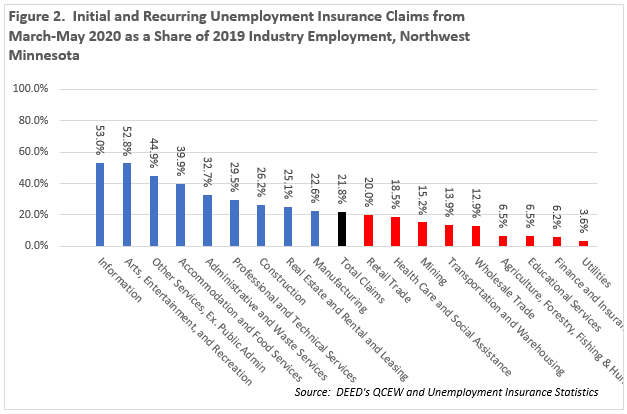 The presence of such industry powerhouses as Polaris, Arctic Cat and New Flyer make Northwest Minnesota a hub of transportation equipment manufacturing.
The presence of such industry powerhouses as Polaris, Arctic Cat and New Flyer make Northwest Minnesota a hub of transportation equipment manufacturing.
From wheat and potatoes to soybeans and sugar beets, the region is a major producer and processor of food staples and specialty agricultural products.
Want the freshest data delivered by email? Subscribe to our regional newsletters.
7/7/2020 9:00:00 AM
Erik White
In response to the COVID-19 pandemic, DEED began publishing daily updates to Unemployment Insurance (UI) statistics, including the number of new applicants and re-activations. This information, which includes demographic, geographic and industry information for the applicants, gives context on who has had their employment impacted by the response to COVID-19. This information can be used by policymakers, industry groups, employers and journalists.
Northwest Minnesota, like the state and nation, experienced a sharp increase in UI applications at the start of the pandemic response, with over 10,000 regional residents applying in both the last week of March and the first week of April. Those were historically high numbers Since the initial layoffs, the number of UI applications dropped every week until the week of June 6 (the last week of data available at the time of this writing), when applications climbed to 2,050 from 1,604, a 27.8% increase. The trend line going forward will be an important indicator of the economy, whether UI applications either continue to increase or decrease. An increase in the future would suggest that the economy is struggling with returning laid-off workers back to their jobs, suggesting long-term effects of the initial response to the pandemic or even delayed impacts as industries struggle to maintain similar demand for products and services (see Figure 1).

The timing of the UI claims is important but so is the industry of the person applying. One way of determining impact on a particular industry is to compare the number of initial UI claims submitted to the total employment within the sector. The most impacted sector so far was information, where 53% of the sector's total employment in the region filed for unemployment insurance. Arts, entertainment, and recreation also had over 50% of employment laid off at one point during the pandemic. Another industry that was hit hard was other services, which includes personal care services like barbers and hair stylists.
At the other end of the spectrum, several industries were less affected by responses to COVID-19. For example, only 3.6% of total workers in the utilities industry submitted initial claims for UI. Likewise, UI claims accounted for less than 10% of employment in the following industries: finance and insurance, educational services, and agriculture, forestry, fishing, and hunting. Overall, cumulative UI applications represented 21.8% of all employment in the Northwest region from March through May, but not every industry was impacted equally by the response to the pandemic, so far (see Figure 2).

Contact Erik White.